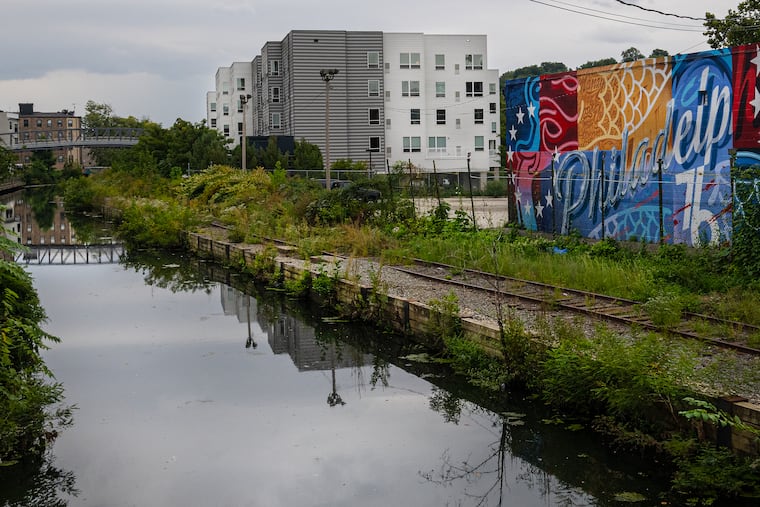More apartments proposed for Manayunk’s Venice Island a year after it was swamped by Hurricane Ida
Another apartment proposal is being made for Venice Island, which was submerged by 2021's Hurricane Ida.

An apartment complex containing 213 new units could be coming to Venice Island, a flood-prone spit of land between the Schuylkill and the Manayunk Canal.
The project, by Rock Urban Development, would almost double the number of homes on Venice Island. It includes two four-story apartment dwellings connected by pedestrian bridges to a two-story amenity building on Main Street Manayunk that doubles as an emergency exit. The site borders the Manayunk Bridge Trail, immediately to the north.
This proposal comes a year after Hurricane Ida swamped Venice Island and much of adjacent Main Street Manayunk, causing millions of dollars in property damage.
But for Nate Torok, president of Rock Development, the climate-change-engorged river isn’t a reason to stop development on this vulnerable site.
“It would be a shame for people to not be able to utilize these areas of Manayunk,” Torok said. “We’re trying to bring people to the beauty of Manayunk and the river and the canal and all the paths and the ability to be outside. That far outweighs any sort of risk that a flood would pose.”
Emergency precautions
Torok says that doesn’t mean they aren’t taking the danger seriously. All of the living space will be elevated 11 feet above the 100-year floodplain, with the ground floor entirely devoted to parking. City regulations require the buildings to be set 50 feet back from the river.
Rock plans to have a staff presence on-site 24 hours a day, along with an early warning system to alert tenants about approaching storms and give them a chance to move their cars out of harm’s way.
As with previous residential developments on Venice Island, there will be the additional pedestrian egress above the floodplain, in this case linking the residential buildings to the amenity space Rock is providing on Main Street. To make room for this new addition, Rock will demolish a building that used to house Christie’s Nail Salon, 4436 Main St., which was heavily damaged by flooding during Hurricane Ida.
“With climate change, all of Main Street Manayunk is impacted,” Torok said. “The flood, the hurricane, devastated a lot of businesses. We’re extremely sensitive to that. We’re working through emergency plans, emergency egress, and escape routes.”
The plan requires no zoning variances. That’s because former Mayor Michael Nutter, then a Council member for the area, rezoned the once-industrial Venice Island for residential development in 1999. That same year Hurricane Floyd hit, and the river rose 14.1 feet, a taste of what was to come.
But neither nature nor a lawsuit from the Manayunk Neighborhood Council, which was defeated at the state Supreme Court, was able to prevent residential developments from springing up on the southern half of the island. Rescue boats were required to save residents from one of the developments in 2014, but another project moved forward a few years later.
Community will weigh in
There are currently about 260 units on Venice Island. The site Rock Development hopes to use is home only to a tiny auto detailing shop.
Torok will face the scrutiny of community meetings because the project contains enough units that it is subject to Civic Design Review, where a committee of municipally appointed architects and planners offers nonbinding critiques.
Torok has “had his eye on the property for a long time. He bought it before Hurricane Ida,” said John Hunter, zoning chair of Manayunk Neighborhood Council. “He wants to make sure that he can get a zoning permit before the city might get their act together with FEMA [Federal Emergency Management Agency] or the Office of Sustainability and decide that they shouldn’t be building in the floodplain.”
The city’s Planning Commission and its expert staff have previously expressed concerns about further residential development on Venice Island, but they serve in a purely advisory capacity, and policymakers have not responded.
Torok said he hasn’t heard of any incoming proposals to change development regulations on the island. The only thing that he’s considering that isn’t in his current proposal is the possibility of adding more parking to the site. Currently he plans 110 spaces, including 25 for car share, seven for electric vehicles, and five ADA-accessible spaces.
The proposal is scheduled to go before the Manayunk Neighborhood Council next week, but Hunter says he does not anticipate strong pushback. With no zoning variances required, neighborhood groups have no real influence over its outcome.
“There are some concerns about the height of the building blocking the view of the bridge, because it’s such an iconic symbol of Manayunk,” Hunter said. “You have these tall buildings, hovering behind Main Street retail stores. But as it’s a by-right scheme, it’s not like [their concerns] have any impact.”